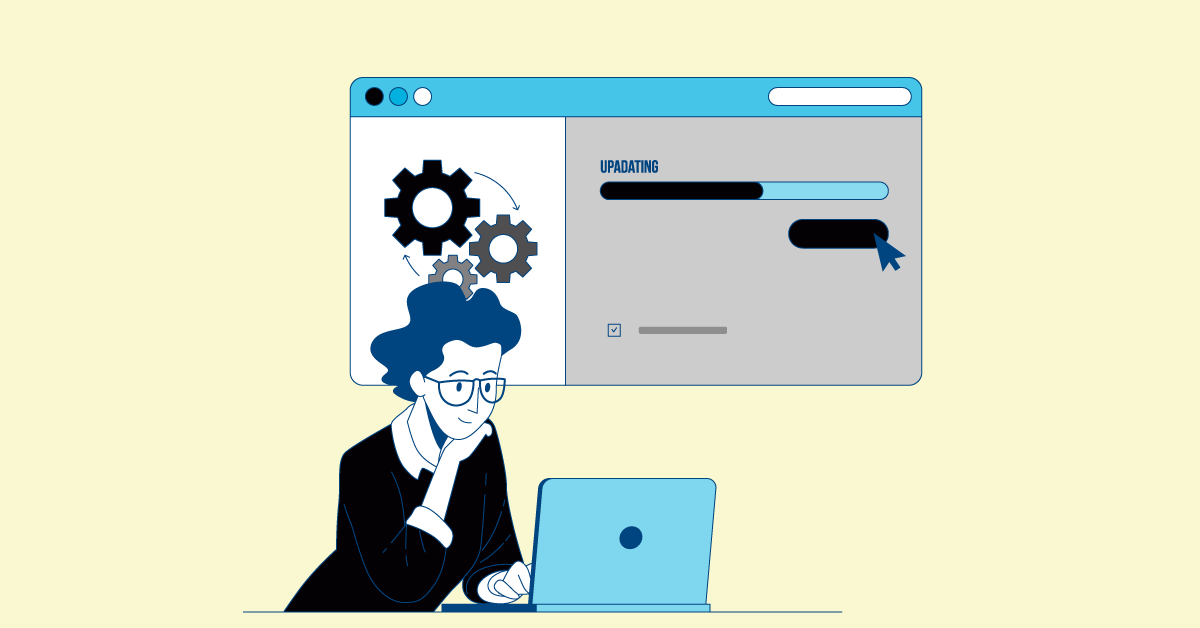Test automation is crucial for modern software development. It helps deliver high-quality applications quickly. Automating tests improves efficiency and reliability, but building in house testing frameworks can be surprisingly complex. Is it really the best use of your resources? This post explores the hidden costs and challenges of DIY test automation. We'll also look at smarter alternatives, like open-source frameworks, commercial tools, and specialized testing services, so you can find the right automated testing solution for your needs.
Despite the allure of tailoring test automation to the unique needs of a development team, this route may divert essential resources and focus from the core functionalities that drive business success. This article explores why organizations probably shouldn't build test automation in-house and which alternatives could better align with a team's objectives.
Should You Handle Test Automation In-House?
Teams should avoid building test automation in-house because it is cost-prohibitive, extremely specific in its skill requirements, and can limit innovation.
Key Takeaways
- In-house test automation drains resources: Factor in developer time, setup, maintenance, and the diversion of resources from core product development. It's more than just writing code; it's a significant, ongoing investment.
- Outsourced automation offers a strategic edge: Providers like MuukTest offer expertise and comprehensive services, letting your team focus on your product and speed up your time-to-market.
- Pick the right automation approach: Balance your project needs, budget, and desired level of customization when choosing between building, buying, or outsourcing. There's no one-size-fits-all solution.
The True Cost of In-House Testing
The decision to develop test automation in-house versus purchasing from specialized vendors involves significant financial implications. Here are key areas where costs are impacted:
- Developer Time and Resource Allocation: In-house development of test automation tools requires substantial commitment from your development team. This commitment includes the initial setup and diverting ongoing development efforts. For instance, a typical automation framework might take several months to develop, during which time your team could instead enhance existing product features or develop new revenue-generating services.
- Initial Setup Costs: Setting up an in-house test automation framework involves costs related to software development tools, integration into existing systems, and possible developer training on new technologies or programming paradigms specific to testing. These setup phases often exceed initial budget estimates due to unforeseen technical challenges.
- Ongoing Maintenance and Updates: Unlike static applications, test automation tools require continual updates to accommodate changes in the software they are testing. This includes adapting tests to new software features, fixing bugs in the automation code, and updating the tool to handle new testing scenarios. Effective maintenance ensures that automated tests remain reliable and relevant, reducing the risk of false positives or undetected issues. For a comprehensive look at these best practices, the automated testing overview from Functionize highlights strategies that address both evolving software needs and the latest in automation technology, ensuring tests keep pace with real-world application changes. The cost of maintaining an in-house solution can significantly increase if the software development lifecycle is highly dynamic.
- Opportunity Costs: In-house development also has an opportunity cost. The time and resources spent developing and maintaining test automation tools are not spent on potentially more valuable activities, such as improving user experience, expanding to new markets, or innovating on the core product.
Initial Investment Costs
Building your own test automation framework involves upfront expenses for software tools, integrating those tools with your current systems, and potentially training developers on new testing-specific technologies. The initial setup phase can easily become more expensive than planned, often due to unexpected technical issues. Think about licensing specific software, setting up the testing environment, and the time it takes to integrate everything smoothly. These costs add up quickly.
Ongoing Maintenance and Upgrades
Test automation tools need regular updates to keep up with the software they're testing. This includes adjusting tests for new features, fixing bugs in the automation code, and ensuring the tool can handle new testing scenarios. Effective maintenance is crucial for reliable and relevant automated tests, minimizing the risk of false positives or missed issues. Functionize offers a good overview of best practices in automated testing, highlighting strategies to manage evolving software and the latest automation tech. Keeping your in-house tools current requires ongoing investment and can become expensive, especially with a fast-paced software development lifecycle.
Personnel Costs: Hiring and Retention
Developing test automation in-house requires a substantial commitment from your development team, both for the initial setup and for ongoing maintenance. This means diverting developers from core product work, which can slow down feature development and innovation. You'll also need skilled developers dedicated to maintaining and updating the automation framework. Finding and retaining these specialists can be challenging, adding to the long-term costs. Consider the salaries, benefits, and potential recruiting fees associated with building and maintaining this specialized team. Services like MuukTest can help alleviate these resource constraints by providing expert QA and automation services.
Maintaining Expertise and Focus
Test automation is a specialized area that requires a distinct skill set, often beyond the general software development skills typically found in product teams. Here are some of the skills essential for effective test automation:
- Proficiency in Automation Frameworks: Skills in frameworks like Selenium, Appium, or Cypress are crucial. These tools require understanding the basic functionality and advanced features that allow for robust, scalable, and maintainable test scripts.
- Scripting and Programming Skills: Effective test automation also demands strong coding skills in languages such as Python, Java, or JavaScript. These skills are necessary to develop scripts that are both efficient and capable of handling complex testing scenarios.
- Continuous Integration/Continuous Deployment (CI/CD) Practices: Knowledge of CI/CD pipelines is essential, as test automation is critical to these processes. Understanding how to integrate automated tests into these pipelines ensures testing is a seamless part of the software delivery process.
- Analytical and Debugging Skills: It is vital to be able to analyze test results, identify issues with the software, and debug test scripts. These skills help pinpoint failures in the software being tested quickly, thereby speeding up the development cycle.
Given the specialized nature of these skills, training existing staff or recruiting new talent can be costly and time-consuming. This specialization can divert resources and focus from core product development, where the existing team's domain expertise and understanding of the product's unique value propositions are more directly applicable.
By contrast, allowing developers to concentrate on enhancing the core functionalities of the product — those features that truly differentiate it in the market — can lead to more innovative and competitive offerings.
Staying Up-to-Date with Evolving Technologies
The tech landscape is constantly evolving. New tools, frameworks, and testing methodologies emerge regularly. Keeping your in-house test automation aligned with these advancements requires continuous investment in training, research, and development. This constant adaptation cycle can strain resources and distract from core product development.
For example, the shift toward mobile-first development necessitates expertise in mobile testing frameworks like Appium. The rise of AI-powered testing tools also requires specialized knowledge to implement and maintain them effectively. Effective maintenance ensures automated tests remain reliable and relevant, reducing the risk of false positives or undetected issues. The automated testing overview from Functionize highlights strategies that address evolving software needs and the latest automation technology, ensuring tests keep pace with real-world application changes. Outsourcing to expert test automation providers like MuukTest allows your team to leverage the latest advancements without the overhead of continuous upskilling and adaptation.
Balancing Testing with Core Business Objectives
Building and maintaining in-house test automation can divert valuable resources from core business objectives. The time, budget, and personnel dedicated to test automation infrastructure could be better allocated to activities directly aligned with business growth, such as product innovation, customer acquisition, and market expansion. Prioritizing core business functions is crucial for long-term success. The opportunity cost associated with in-house development is significant. Instead of focusing on building and maintaining testing tools, your team could be improving user experience, expanding to new markets, or innovating on the core product. You can find more information on balancing software quality with user feedback on the MuukTest blog.
Outsourcing test automation to specialized providers like MuukTest allows your team to focus on what they do best: building and improving your core product. This strategic allocation of resources ensures your business remains competitive and agile in the market. By leveraging MuukTest's expertise and comprehensive test automation services, you can achieve complete test coverage within 90 days, freeing up your internal teams to concentrate on driving business growth and innovation. Learn more about how to get started with our QuickStart program and check out our pricing plans.
The Benefits of Vendor Support
Opting for vendor-supplied test automation tools gives companies access to the latest features and innovations in the testing field without needing internal development. These vendors invest heavily in research and development to ensure their tools are at the forefront of technology trends and best practices. Additionally, the support provided by vendors is typically comprehensive and specialized, offering quick resolutions to any issues that arise, which can dramatically reduce downtime and improve efficiency.
Access to Expertise and Best Practices
Choosing vendor-supplied test automation tools gives your company access to cutting-edge features and innovations without requiring in-house development. These vendors invest heavily in research and development, ensuring their tools utilize the latest technology trends and best practices. For example, a vendor like MuukTest specializes in AI-powered test automation, offering comprehensive test coverage efficiently and cost-effectively. This expertise translates into more robust and reliable testing for your applications. This also means access to expert QA professionals, seamless integration with CI/CD workflows, and scalable solutions tailored to your needs. You can explore their customer success stories here.
Reduced Overhead and Scalability
Building an in-house test automation framework often requires significant upfront investment and ongoing maintenance. This can strain resources and divert attention from core product development. Using a vendor-supplied solution reduces this overhead, allowing your team to focus on what they do best: building and improving your product. Plus, vendor solutions typically offer better scalability, adapting to your needs as your product and user base grow. This frees up your team to focus on features that differentiate your product, leading to more innovative and competitive offerings. For more details on pricing and scalability, visit the pricing page.
Faster Implementation and Time-to-Market
Developing test automation in-house can be a lengthy process, delaying your product's release. Vendor-supplied tools can be implemented much faster, accelerating your time-to-market. This speed advantage is crucial in today’s competitive landscape. Furthermore, vendor support is usually comprehensive and specialized, offering quick solutions to any problems that arise. This minimizes downtime and improves overall efficiency. If you're looking for a quick start with AI-powered test automation, explore MuukTest's services to see how they can achieve complete test coverage within 90 days.
Exploring Automated Testing Solutions
Like the old saying goes, you don't have to reinvent the heel. There are many alternatives out there which may provide you with the solutions you need for your test automation. These alternatives, each with unique advantages and challenges, cater to different operational needs and resource allocations.
Open-Source Test Automation Frameworks: Pros and Cons
Open-source test automation frameworks are attractive to many companies due to their affordability and the robust support communities that back them. These frameworks are freely available and continually enhanced by a global community of developers and testers. However, deploying and maintaining these frameworks requires a certain level of expertise. Here are some key points to consider:
Pros:
- Cost-Effectiveness: Virtually no upfront costs, as these tools are freely available for modification and use.
- Community Support: Large support communities provide updates and troubleshooting assistance, which can be invaluable for solving complex issues.
- Continuous Improvement: Frequent updates and improvements from the community help keep the tools relevant and robust.
Cons:
- Expertise Required: Effective implementation requires coding and framework customization knowledge, which may necessitate training or hiring specialized personnel.
- Customization Needs: While highly customizable, these frameworks require time and technical skills to tailor them to specific project requirements.
Flexibility and Customization Options
One of the biggest draws of open-source frameworks is their flexibility. You can tailor them to fit specific project needs, a huge plus for teams with unique testing requirements. This customization gives you a high degree of control over the testing process, enabling bespoke solutions. Need to integrate with a specific CI/CD pipeline? No problem. Want to create custom reporting? Go for it. This adaptability is rarely found in commercial, off-the-shelf solutions. However, this flexibility is a double-edged sword. While offering extensive customization, open-source frameworks demand a deep understanding of the framework's architecture and often require significant coding expertise. This can lead to a steeper learning curve and increased development time.
Community Support and Resources
Open-source frameworks benefit from large, active communities. These communities offer a wealth of knowledge and support, often exceeding what's available for commercial products. Think forums, documentation, tutorials, and readily available code examples. This collaborative environment fosters continuous improvement and provides a valuable resource for troubleshooting. Stuck on a problem? Chances are someone in the community has encountered it before and can offer guidance. This collaborative approach to problem-solving can significantly reduce development time and improve the overall quality of your test automation suite. This robust community support is a major advantage, providing access to a collective intelligence that can be invaluable for overcoming challenges and staying up-to-date with best practices. For more on community support, see our post on exploring automated testing solutions.
Potential Challenges and Limitations
While the flexibility and community support are attractive, open-source frameworks present challenges. The most significant hurdle is the technical expertise required. Building and maintaining an effective test automation framework demands strong coding skills and a deep understanding of testing methodologies. This can be a significant investment, especially for smaller teams or those lacking dedicated test automation engineers. Additionally, while the initial cost of the framework itself is zero, the cost of training, development, and ongoing maintenance can add up. Another factor is the ongoing commitment required to keep the framework up-to-date. As your software evolves, so too must your test automation. This continuous adaptation requires dedicated resources and can become a significant burden. If your team isn't prepared for this long-term investment, an open-source framework might not be the best fit. For teams looking for a faster, more efficient approach, MuukTest offers comprehensive test automation services that can help you achieve complete test coverage within 90 days.
Commercial Test Automation Tools: Worth the Investment?
Commercial test automation tools provide a more comprehensive solution with user-friendly interfaces facilitating quicker adoption and integration into existing workflows. These tools are designed to meet various testing needs and often come with extensive vendor support. However, they also present particular challenges and considerations:
Pros:
- Advanced Features: Include built-in best practices, advanced testing capabilities, and integration options with other software tools.
- User-Friendly Interfaces: Typically easier for non-specialists to use, which can reduce training time and accelerate testing processes.
- Vendor Support: Robust support, including troubleshooting, training, and regular updates that keep the tools aligned with current technologies.
Cons:
- Cost Implications: Higher ongoing costs due to subscription fees and possible additional costs for extra features or users.
- Vendor Lock-In: Potential dependency on the vendor for updates and support can limit operational flexibility and future scalability.
Test Automation Services: A Balanced Approach
Engaging a specialized test automation service provider offers a strategic blend of efficiency, expertise, and cost-effectiveness. These providers bring deep expertise in test automation, handling the complexities while allowing internal teams to focus on core product development. This approach offers several key advantages:
Comprehensive Features and Functionality: Opting for vendor-supplied test automation tools gives companies access to the latest features and innovations in the testing field without needing internal development. These vendors invest heavily in research and development to ensure their tools are at the forefront of technology trends and best practices. This can lead to more efficient testing processes and better coverage, ultimately resulting in higher quality software. For example, a service like MuukTest is known for its AI-powered approach, offering comprehensive test coverage within 90 days.
Dedicated Support and Maintenance: Vendor support is typically comprehensive and specialized, offering quick resolutions to any issues that arise, which can dramatically reduce downtime and improve efficiency. This dedicated support frees up internal teams to focus on their primary responsibilities, rather than getting bogged down in troubleshooting test automation tools. Having expert support readily available can be invaluable when dealing with complex testing scenarios or tight deadlines.
Cost Considerations and ROI: Choosing between in-house development versus purchasing from specialized vendors involves significant financial implications. Building test automation tools in-house requires a substantial commitment from your development team, including the initial setup and ongoing maintenance. These costs can escalate quickly, especially with a dynamic software development lifecycle. Outsourcing to a specialized provider often offers a more predictable and manageable cost structure, allowing for better budget planning and resource allocation. You can explore MuukTest's pricing to understand potential cost savings.
Choosing the Right Test Automation Approach
Selecting the right test automation strategy is crucial for companies to align with their project's needs and long-term goals.
Matching Solutions to Your Project Needs and Budget
When assessing a project's requirements, determine the complexity of the tasks that require automation. This includes identifying frequent and critical test cases that benefit most from automation, like regression or load testing.
A detailed cost-benefit analysis should follow, comparing the expense of developing these capabilities in-house versus the costs associated with purchasing or licensing third-party solutions. Budget considerations should also account for potential scalability needs, foreseeing future expansions that may necessitate more sophisticated testing frameworks.
Balancing Cost, Expertise, and Support
Decision-makers must carefully evaluate the cost implications, not just upfront but over the life cycle of the test automation implementation. This evaluation includes considering the cost of training staff on new tools versus utilizing existing skill sets. If the current team lacks experience in advanced test automation practices, the learning curve and the time to productivity must be factored into the decision.
Ongoing support is another critical consideration. External vendors typically offer robust support services, software updates, and system maintenance, which can offset internal resource demands and reduce the total cost of ownership.
Customization vs. Ease of Use: Finding the Right Fit
Customization allows companies to tailor test automation tools to their needs, leading to more efficient testing cycles and more relevant results. However, highly customized solutions can become complex and require continuous updates and checks.
On the other hand, standardized, off-the-shelf software solutions offer ease of use, faster setup times, and lower maintenance requirements. The ideal solution often lies in a hybrid approach, utilizing customizable yet user-friendly platforms that provide the flexibility to adapt to changing needs without extensive additional investment. Tools that offer modular customization options, allowing for incremental adjustments, can be particularly beneficial.
Different Types of In-House Testing
“In-house testing” can mean different things in different industries. Let’s clarify a few common uses of the term.
In-House Testing in Healthcare
In healthcare, in-house testing refers to lab work performed within a medical facility, like a doctor’s office or hospital, rather than sending samples to an external lab. In-house lab services offer faster results, leading to quicker diagnoses and treatment. It’s also generally more convenient for patients, as everything happens in one location, improving communication between patients and doctors.
In-House Testing in Manufacturing
For manufacturers, in-house testing means evaluating products or components within their own facilities. This approach offers advantages like speed, lower costs, and customization. It eliminates shipping time and external lab coordination, leading to quicker turnaround times for quality checks.
In-Home Usage Testing (IHUT)
In-home usage testing (IHUT) is a market research method where consumers test products in their own homes. This provides realistic feedback, helping companies understand if a product truly meets customer expectations and identify areas for improvement before a full product launch.
Reference Lab Testing (as a contrast to in-house)
Reference labs offer specialized tests that hospitals may not perform regularly in-house. These tests often require specialized equipment or expertise not readily available within a standard hospital setting. This allows hospitals to offer a wider range of tests without investing in rarely used equipment.
Automating Test Cases: Increasing the Cost of Ownership?
While automating test cases offers numerous benefits, building this capability in-house can significantly increase costs in several key areas.
Initial Setup and Integration Costs
Setting up an in-house test automation framework involves costs for software development tools, integrating the framework into existing systems, and potentially training developers on new testing-specific technologies. As discussed in MuukTest’s analysis of in-house testing costs, these initial setup phases can often exceed budget estimates due to unforeseen technical challenges.
Maintenance, Updates, and Troubleshooting
Test automation tools require ongoing updates to stay compatible with the software they test. This includes adapting to new features, fixing bugs in the automation code, and ensuring the tool handles new testing scenarios effectively. Effective maintenance is crucial for reliable and relevant automated tests, minimizing false positives and ensuring real issues are caught. This ongoing maintenance represents a significant long-term cost.
The Need for Skilled Automation Engineers
Test automation demands a specialized skill set, often exceeding the general software development skills found in most product teams. Maintaining this expertise in-house requires significant investment in training or hiring specialized automation engineers, adding to the overall cost. This can lead to higher salaries and increased competition for talent.
Advantages of an Automation Framework
A well-implemented automation framework, whether built in-house or acquired from a vendor, offers several key advantages.
Standardization and Reusability
Standardization within a test automation framework promotes reusability of test scripts and components. This streamlines the testing process, making it more efficient and allowing teams to adapt quickly to changing software requirements. This reduces redundant work and speeds up the testing process.
Improved Test Coverage and Efficiency
Automation inherently improves both the efficiency and coverage of testing. Automated tests can run repeatedly and quickly, covering a wider range of scenarios and edge cases than manual testing, leading to more robust and reliable software. This increased coverage helps identify potential issues earlier in the development cycle.
Reduced Test Maintenance and Execution Time
While maintaining the automation framework itself requires effort, a well-designed framework ultimately reduces the time spent on executing and maintaining individual tests. This efficiency frees up QA teams to focus on more strategic testing activities, such as exploratory testing and user acceptance testing.
MuukTest: Your Partner for Comprehensive Test Automation
MuukTest offers a compelling alternative to building in-house test automation, providing comprehensive solutions tailored to your specific needs.
Achieve Complete Test Coverage Within 90 Days
MuukTest's expertise enables rapid implementation and achieving complete test coverage within 90 days. This accelerated timeline allows you to realize the benefits of automation quickly, without the long lead times associated with in-house development. Visit our customer page to see how we've helped other businesses.
Expert QA and Seamless CI/CD Integration
MuukTest provides expert QA services and seamless integration with your existing CI/CD pipelines. This ensures that testing is a fully integrated part of your software delivery process, streamlining workflows and improving overall efficiency. Learn more about our test automation services.
Scalable Solutions Tailored to Your Needs
MuukTest offers scalable solutions designed to adapt to your evolving needs. Whether you're a small startup or a large enterprise, MuukTest can tailor its services to fit your specific requirements and budget. Explore our pricing and see how we can help you achieve your testing goals. Ready to get started? Check out our QuickStart guide.
Getting Started with Test Automation
A well-defined testing strategy is critical for any software development project, ensuring products not only meet the required standards but also deliver the best possible user experience. While building test automation in-house may seem attractive for those seeking complete control and customization, companies should consider all available options. This evaluation helps to align their specific needs with the most effective testing solution, whether it involves buying, building, or a blend of both.
In some scenarios, in-house test automation development could be a good fit. Companies with highly specialized needs that existing tools cannot adequately address, or those where security and data privacy are paramount, may benefit from tailor-made solutions. Additionally, organizations that already possess a strong internal team of test automation experts might find their in-house skills could lead to competitive innovations.
Ultimately, the decision to build or buy should not be taken lightly. It involves a thorough analysis of the company's immediate and long-term needs, available resources, and strategic goals.
Talk to Our Test Automation Experts
We invite you to share your experiences with test automation. Whether you've built in-house solutions, leveraged open-source frameworks, or employed commercial tools, your insights can help others in the community make informed decisions. Join the discussion below and let us know how test automation has impacted your projects.
We offer a range of resources for those seeking to deepen their understanding of test automation strategies and tools. To access more articles on topics like this, visit our blog, or check out our case studies, to get more expert advice designed to enhance your testing processes and ensure the success of your software development efforts.
Related Articles
- Pros and Cons to Building Test Automation In-House
- Your Ultimate Guide to Test Automation Services
- 7 Key Benefits of Test Automation for Modern Businesses
- Test Automation Frameworks: Your Ultimate Guide
- Automated Testing Tools: Your Ultimate Guide
Frequently Asked Questions
What if my company has very unique testing needs? Won't building in-house be better? While it's true that building in-house allows for extensive customization, consider whether the investment in development and maintenance is worthwhile. A vendor like MuukTest can often tailor solutions to meet specific requirements, potentially offering a faster and more cost-effective approach than building from scratch. Evaluate if the level of customization truly necessitates in-house development or if a tailored vendor solution can suffice.
We already have some automation in place. Can we integrate that with MuukTest's services? MuukTest specializes in integrating with existing systems and workflows, including current CI/CD pipelines. Reach out to them directly to discuss your current setup and explore how they can integrate with your existing automation processes.
Is open-source automation a good starting point if we have limited resources? Open-source can be a viable option, but remember that "free" doesn't mean "no cost." Consider the expertise needed to implement and maintain open-source frameworks. While the initial price is attractive, the investment in training, customization, and ongoing updates can be substantial. Weigh these hidden costs against the benefits of a vendor solution that offers dedicated support and maintenance.
How can I convince my team to switch from our current in-house solution? Focus on the long-term benefits of outsourcing test automation. Highlight how it frees up internal resources to focus on core product development, leading to faster innovation and potentially higher revenue generation. Quantify the costs of maintaining your current in-house system, including developer time, maintenance expenses, and the opportunity cost of diverting resources from other projects. Present MuukTest as a strategic investment that streamlines testing, reduces overhead, and allows your team to focus on what they do best.
What if we're a small startup with a limited budget? Is MuukTest still an option? MuukTest offers scalable solutions designed to accommodate various budgets and needs. They work with both startups and large enterprises, tailoring their services accordingly. Explore their pricing plans and consider the long-term cost savings of outsourcing compared to the ongoing investment of building and maintaining an in-house solution, even a small one. It might be more affordable than you think.












